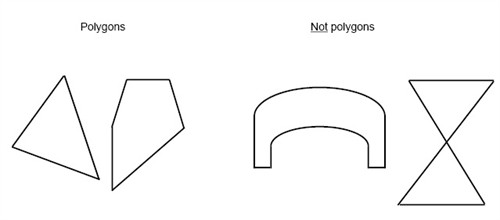Polygons
A polygon is a closed figure where the sides are all line segments. Each side must intersect exactly two others sides but only at their endpoints. The sides must be noncollinear and have a common endpoint.

A polygon is usually named after how many sides it has, a polygon with n-sides is called a n-gon. E.g. the building which houses United States Department of Defense is called pentagon since it has 5 sides.
Kindle Unlimited Membership Plans
Kindle Unlimited Membership Plans
Types of Polygons
Regular or Irregular
A regular polygon has all angles equal and all sides equal, otherwise it is irregular
 |  | |
| Regular | Irregular |
Concave or Convex
A convex polygon has no angles pointing inwards. More precisely, no internal angle can be more than 180°.
If any internal angle is greater than 180° then the polygon is concave. (Think: concave has a "cave" in it)
 |  | |
| Convex | Concave |
Simple or Complex
A simple polygon has only one boundary, and it doesn't cross over itself. A complex polygon intersects itself! Many rules about polygons don't work when it is complex.
 |  | |
| Simple Polygon (this one's a Pentagon) | Complex Polygon (also a Pentagon) |
Interior angles of polygon
An Interior Angle is an angle inside a shape

Sum of Interior Angles = (n-2) × 180°
If a polygon is regular (i.e. all of its sides are of equal length and all of its angles are of equal size), then the following rule is true:
Each Interior Angle of a Regular Polygon = (n-2) × 180° / n
Where 'n' refers to the number of sides.
The exterior angle of a polygon is an angle between any side of a shape and a line extended from the next side.
When you add the exterior angle of a polygon and its corresponding and exterior angle on a straight line, it amounts to 180°.
As a rule;
The sum of the exterior angles of a simple polygon add up to 360°
This is referred to as a 'full revolution'.
The exterior angle of a polygon and its corresponding interior angle always add up to 180°. This is due to the fact that the two corresponding angles create a straight line:
Exterior angle of a regular polygon = 360° ÷ (number of sides)







No comments:
Post a Comment